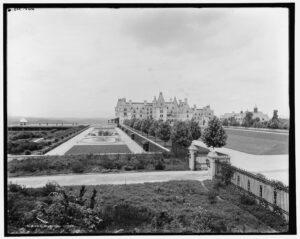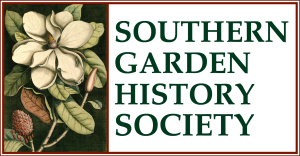
Credit: Library of Congress, William Henry Jackson photographer
While often imposing in unique ways, gardens and homes visited by the Society have never matched the near-surreal scale and grandeur of Biltmore, the National Historic Landmark estate that was the central focus of our 1998 annual meeting. Chief credit for heading up event organization and execution went to board member and meeting chair Bill Alexander, then Biltmore’s curator of landscapes.*
On the “scale” side of the matter, consider that the palette established by owner George W. Vanderbilt encompassed about eight-thousand acres, with overall “grandeur” being provided by the surrounding Blue Ridge Mountains. While Vanderbilt used William Morris Hunt to design a chateau of proportions unequaled in America, it was Frederick Law Olmsted who would develop the concepts for the adjacent “home grounds” we visited in 1998. He was an obvious choice for Vanderbilt, given Olmsted’s unrivalled body of work. The aging Connecticut native was to make this his last large commission, Biltmore becoming a master stroke that would effectively join Central Park to “bookend” his landscape architecture career. (To understand the story best, however, and the gardens’ evolution over many decades, it is helpful to investigate the impact of horticulturist Chauncey Delos Beadle. Recommended to Vanderbilt by Olmsted, Beadle was employed here from the 1890s until he died in 1950.)
This writer well remembers joining Society friends to explore the expansive garden rooms on the sloping southwest side of the mansion, starting with the terraces by the house, the wisteria-covered loggia, and the Italian Garden one terrace below. Restored in recent years, the Italian Garden features five parterres featuring grass panels at either end and three large curvilinear-edged pools in the middle. Horticulturally speaking, this was envisioned as, and continues to be, a water garden of the highest standards.**
Immediately east of the Italian Garden, the Shrub Garden and its serpentine paths dramatically shift the landscape experience from an Italian Renaissance vocabulary to a garden seeming to recall Olmsted’s 1850 visit to Liverpool’s Birkenhead Park and his subsequent large-scale work in New York City. Use of a wide-net term like “shrub” requires a garden to include an extensive plant offering, yet this ten-acre area answers the challenge by presenting over five-hundred distinct types with bloom times spanning the seasons. Paths from here also lead to a distinct Spring Garden, a glen covered over with a broad array and variety of azaleas.
A visitor’s experience with formal landscapes resumes explosively on leaving the Shrub and Spring Gardens and entering the geometrically conceived Walled Garden and Rose Garden (shades of André Le Nôtre and Dezallier d’Argenville), plus the Conservatory area. Labor-intensive carpet bedding, so popular during the later Victorian years, continues in the Walled Garden, involving a staggeringly large number of plant and color choices. The neighboring Rose Garden (the Vanderbilts were great rose fanciers) is defined by brick paths and latticed arbors and offers up over two-hundred-fifty rose varieties. In total, over two-thousand roses grow there, including antiques such as Teas, Bourbons, and Noisettes.
Dating to 1895, Biltmore’s William Morris Hunt-designed conservatory could potentially absorb an entire estate visit, just as a review of its history could merit an article in Magnolia. The main structure is a statement in Palladian balance and symmetry, built of brick, stuccoed-brick, and glass, while abutting greenhouses offer spaces for myriad types of tropical and tender plants. Demonstrating the influence on Hunt, Olmsted, and Vanderbilt of such structures as London’s Kew Gardens Palm House, the conservatory’s central block rises to forty feet, thus allowing several palm varieties to share space with a variety of bromeliads and other plants embracing year-round warm, humid conditions. ***
This discussion of the mansion’s gardens, which range from large to truly grand, only addresses that immediate portion of the Biltmore property perhaps of greatest interest to SGHS members. In addition, of major importance are the Olmsted-designed access way, the carriage roads, and various water features such as the Bass Pond. Biltmore, moreover, is renowned as the birthplace of American forestry. Again, it was Olmsted, as he had done with Chauncey Beadle, who encouraged George Vanderbilt to bring in Gifford Pinchot to develop a management plan for an often worked-out mass of land that in the end would total 125,000 acres.
In varying ways, all of this fell under the professional purview of our 1998 meeting planner, Bill Alexander, who was referenced in paragraph one. Alexander retired from Biltmore in 2018, but his presence there is kept alive through writings about what he knew and loved so well, beginning as a child growing up in Asheville. **** Several of those publications are cited below as recommended reading.
*****************************************************************
Recommended reading: Bill Alexander, The Biltmore Nursery: A Botanical Legacy (2007) and The Biltmore Estate: Gardens and Grounds (2015).
*For the Magnolia meeting article, see:
https://southerngardenhistory.org/wp-content/uploads/2015/12/Magnolia_Summer_1998.pdf#page=1
**For an excellent overview of the Italian Garden and other garden rooms at Biltmore, see:
https://www.biltmore.com/blog/visit-itinerary-garden-lovers-guide-to-biltmore/
***https://www.blueridgebotanic.com/blog/a-winter-oasis-the-biltmore-conservatory
****https://www.biltmore.com/blog/biltmores-landscape-and-forest-historian/

Leave a Reply